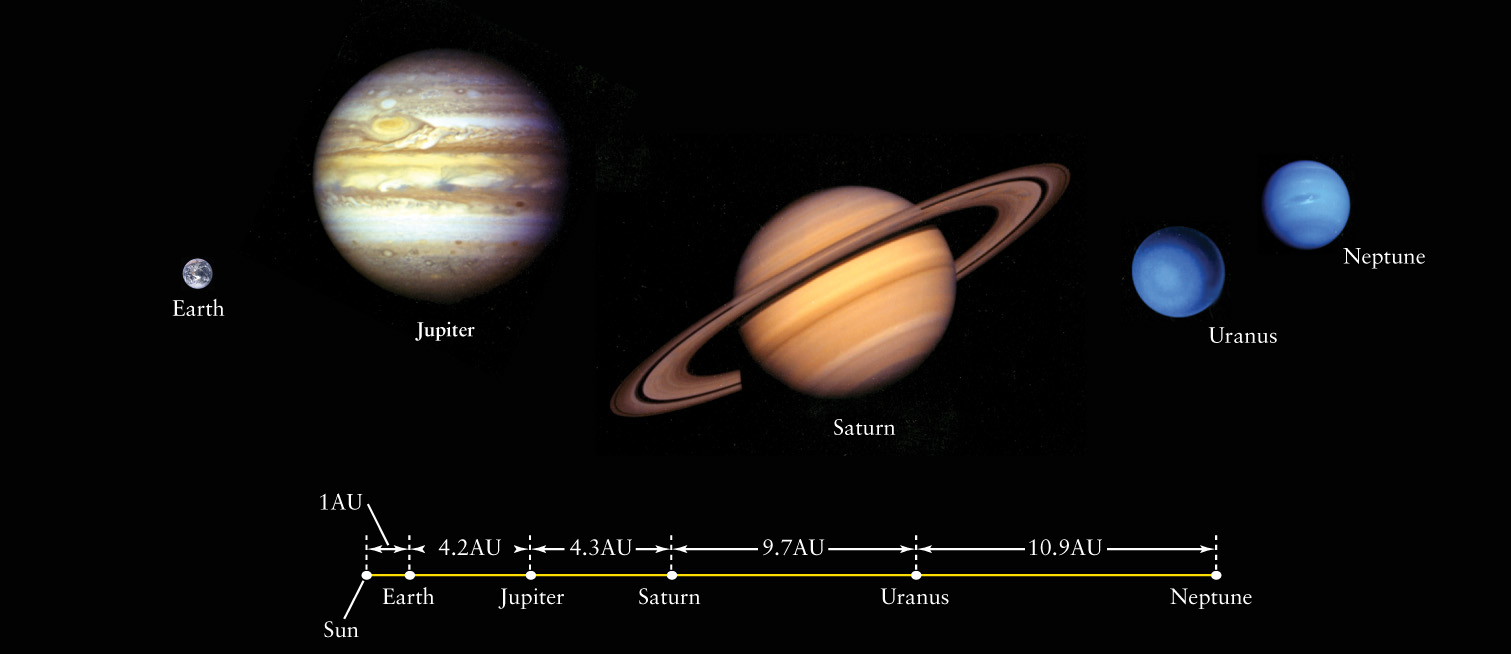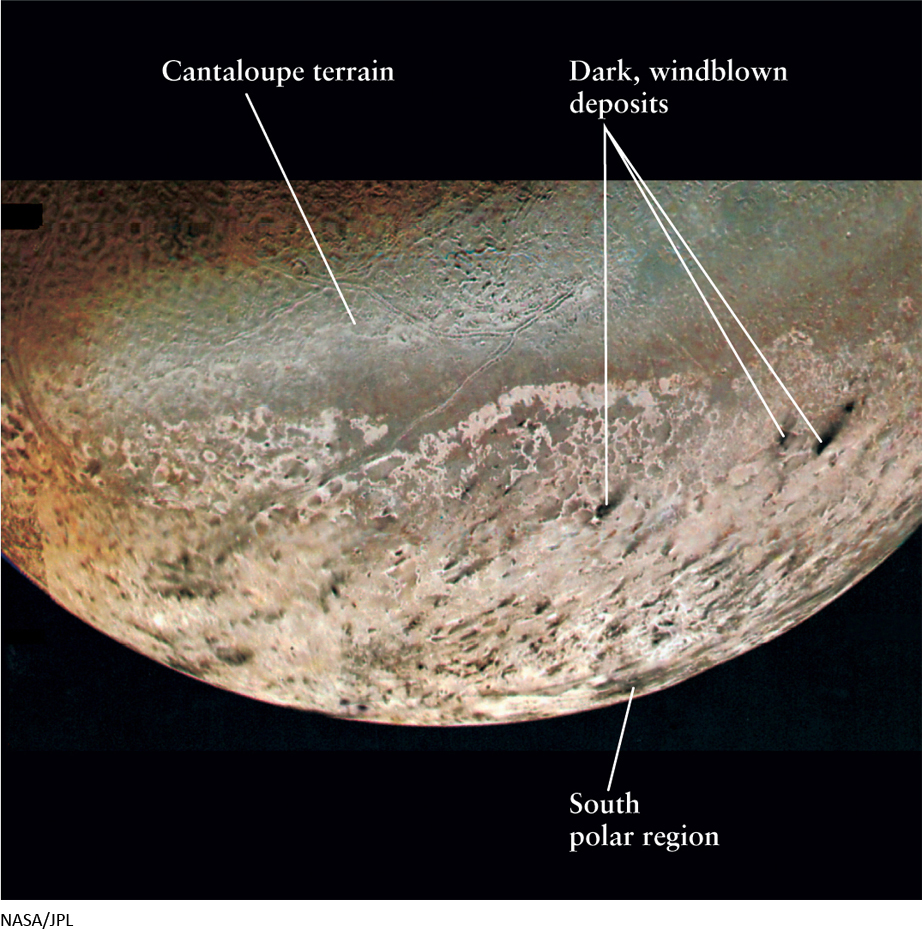7-3 Saturn’s moon Titan and Neptune’s moon Triton exhibit unexpected atmospheres
Each time we send spacecraft to obtain close-up views of distant planets, we find perhaps even more intriguing and unexpected observations of the unusual moons orbiting our gas giant planets. There are more than 100 of these orbiting objects, each one significantly different from the next (see Table 4.2). We discussed some of the dynamic geological processes shaping the surfaces of these objects in the last chapter. Now that we have discussed the nature of their larger host planets, we are in a position to explore the nature of their atmospheres. We will limit our discussion to focus on the two objects with the most interesting atmospheres.
Saturn’s Moon Titan
Unlike Jupiter, Saturn has only one large satellite that is comparable in size to our Moon. This satellite, Titan, has a diameter of 3200 mi (5150 km), which makes it second largest in size among all moons in the solar system. Titan has a low density that suggests it is made of a mixture of ice and rock. But unlike Ganymede or any other satellite in the solar system, Titan has a thick atmosphere with a unique chemical composition.
On Earth water can be a gas (like water vapor in the atmosphere), a liquid (as in the oceans), or a solid (as in the polar ice caps). On Titan, the atmospheric pressure is so high and the surface temperature is so low—about −288°F (−178°C or 95 K)—that any water is frozen solid. But conditions on Titan are just right for methane and ethane to exist as gases, liquids, or solids. This raises the tantalizing possibility that Titan could have methane rain and lakes of liquid ethane.
177
COSMIC CONNECTIONS The Outer Planets: A Comparison
Uranus and Neptune are not simply smaller versions of Jupiter and Saturn. This table summarizes the key differences among the four Jovian planets.
| Interior | Surface | Rings | Atmosphere | |
|---|---|---|---|---|
| Jupiter | Terrestrial core, liquid metallic hydrogen shell, liquid hydrogen mantle | No solid surface, atmosphere gradually thickens to liquid state, belt and zone structure, hurricanelike features | Yes | Primarily H, He |
| Saturn | Similar to Jupiter, with bigger terrestrial core and less metallic hydrogen | No solid surface, less distinct belt and zone structure than Jupiter | Yes | Primarily H, He |
| Uranus | Terrestrial core, liquid water shell, liquid hydrogen and helium mantle | No solid surface, weak belt and zone system, hurricanelike features, color from methane absorption of red, orange, yellow | Yes | Primarily H, He, some CH4 |
| Neptune | Similar to Uranus | Like Uranus | Yes | Primarily H, He, some CH4 |
| For detailed comparisons between planets, see Appendices 1 and 2. | ||||

178
Nitrogen in Titan’s atmosphere can combine with airborne hydrocarbons to produce other compounds, such as hydrogen cyanide (HCN). Hydrogen cyanide, along with other molecules, can join together in long, repeating molecular chains that, when suspended in the atmosphere, are thought to be responsible for the reddish-brown color seen when it was first observed.
The designers of the Cassini mission to Saturn made the exploration of Titan a central goal. During its primary mission in Saturn orbit from 2004 to 2008, the Cassini spacecraft made 44 close flybys of Titan. Titan’s atmosphere is more transparent to infrared wavelengths than to visible light, so Cassini used its infrared telescope to obtain the first detailed images of the satellite’s surface (Figure 7-15a). Most of the surface is light-colored, but a swath of dark terrain extends around most of Titan’s equator.

Cassini has used its on-board radar to map the dark terrain. (Like infrared light, radio waves can pass through Titan’s atmosphere.) These images reveal a series of long, parallel lines of sand dunes about a mile (0.6 km) apart. These are aligned west to east, in the same direction that winds blow at Titan’s equator, and so presumably formed by wind action. Unlike Earth sand, which is made of small particles of silicate rock, sand on Titan is probably small particles of water ice combined with molecules that have fallen from Titan’s atmosphere, which give the dark terrain its color.
The most remarkable images of Titan’s surface have come from Huygens, a small lander that Cassini carried on its journey from Earth and released before entering Saturn orbit. Named for the discoverer of Titan, Huygens entered Titan’s atmosphere on January 14, 2005. The lander took 2½ hours to descend to the surface under a parachute, during which time it made detailed images of the terrain (Figure 7-15b). After touchdown, Huygens continued to return data for another 70 minutes (Figure 7-15c) before its batteries succumbed to Titan’s low temperatures.
Huygens images such as Figure 7-15b show that liquids have indeed flowed on Titan like water on Earth. Yet none of the images made by the lander during its descent or after touchdown showed any evidence of standing liquid. There was nonetheless evidence of recent methane rainfall at the Huygens landing site. A lander instrument designed to measure atmospheric composition was equipped with a heater for its gas inlet. During the 3 minutes it took to warm this inlet, the measured methane concentration jumped by 30% and then remained steady. The explanation is that the ground was soaked with liquid methane that had fallen as rain and evaporated as it was warmed by the heater. Huygens measurements indicate that the average annual methane rainfall on Titan is about 2 inches (5 cm), about the same as the amount of water rain that falls each year at Death Valley in California. The rivers and outflow channels that Huygens observed during its descent may date from an earlier period in Titan’s history when methane was more abundant and rainfall was more intense. What is curious is that within the next several hundred million years methane outgassing from the surface of Titan will cease for good. In time the hydrocarbon haze will disappear, the skies will clear, and the surface of Titan will be revealed to whichever outside observers may gaze upon it in that distant era.
Question
ConceptCheck 7-7: Prior to the Huygens probe, why was solittle known about the surface of Titan?
179
Neptune’s Moon Triton
Thirteen moons have been discovered so far orbiting the planet Neptune, which is twice as far from the Sun as Uranus and extremely difficult to observe. The moons are named for mythological beings related to bodies of water. (Neptune itself is named for the Roman god of the sea.) Most of these worlds are small, icy bodies, probably similar to the smaller satellites of Uranus. The one striking exception is Triton, Neptune’s largest satellite. In many ways Triton is quite unlike any other world in the solar system. One difference is that it harbors a thin atmosphere, making it the only satellite besides Titan to have one.
Figure 7-16 shows the icy, reflective surface of Triton as imaged by Voyager 2 as it rapidly passed by. There is a conspicuous absence of large craters, which immediately tells us that Triton has a young surface on which the scars of ancient impacts have largely been erased by tectonic activity. There are areas that resemble frozen lakes and may be the calderas of extinct ice volcanoes. In the upper portion of Figure 7-16 you can see dimpled, wrinkled terrain that resembles the skin of a cantaloupe.

There may still be warmth in Triton’s interior today. Voyager 2 observed plumes of dark material being ejected from the surface to a height of 5 mi (8 km). These plumes may have been generated from a hot spot far below Triton’s surface, similar to geysers on Earth. Alternatively, the energy source for the plumes may be sunlight that warms the surface, producing subsurface pockets of gas and creating fissures in the icy surface through which the gas can escape.
Triton’s surface temperature is only −391°F (−235°C = 38 K), the lowest of any world yet visited by spacecraft. This temperature is low enough to solidify nitrogen, and indeed the spectrum of sunlight reflected from Triton’s surface shows absorption lines due to nitrogen ice as well as methane ice. But Triton is also warm enough to allow some nitrogen to evaporate from the surface, like the steam that rises from ice cubes when you first take them out of the freezer. Voyager 2 confirmed that Triton has a very thin nitrogen atmosphere with a surface pressure of only 1.6 × 10−5 atm, about the same as at an altitude of 60 mi (100 km) above Earth’s surface. Despite its thinness, Triton’s atmosphere has noticeable effects. The first evidence of an atmosphere on Triton came when Voyager 2 saw streaked areas on Triton’s surface where dark material had been blown downwind by a steady breeze (see Figure 7-16). It also observed dark material ejected from the geyserlike plumes being carried as far as 100 mi (160 km) by high-altitude winds.
Question
ConceptCheck 7-8: How was an atmosphere detected on Triton?